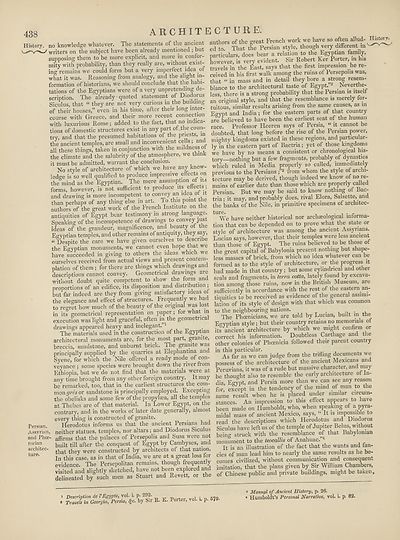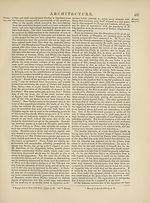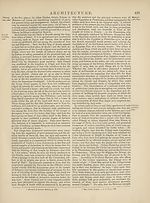Encyclopaedia Britannica > Volume 3, Anatomy-Astronomy
(446) Page 438
Download files
Complete book:
Individual page:
Thumbnail gallery: Grid view | List view

architecture.
438
History, no knowledge whatever. The statements of the ancient
writers on the subject have been already mentioned ; but
supposing them to be more explicit, and more in confor¬
mity with probability, than they really are, without exist¬
ing remains we could form but a very imperfect idea ot
what it was. Reasoning from analogy, and the slight in¬
formation of historians, we should conclude that the habi¬
tations of the Egyptians were of a very unpretending de¬
scription. The already quoted statement of Diodorus
Siculus, that “ they are not very curious in the building
of their houses,” even in his time, after their long inter¬
course with Greece, and their more recent connection
with luxurious Rome; added to the fact, that no indica¬
tions of domestic structures exist in any part of the coun¬
try, and that the presumed habitations of the priests, in
authors of the great French work we have so often allud¬
ed to. That the Persian style, though very different in
particulars, does bear a relation to the Egyptian family,
however, is very evident. Sir Robert Ker Porter in his
travels in the East, says that the first impression he re¬
ceived in his first walk among the rums of Persepohs was,
that “ in mass and in detail they bore a strong resem¬
blance to the architectural taste of Egypt. 2 Neverthe¬
less, there is a strong probability that the Persian is itself
an original style, and that the resemblance is merely for¬
tuitous, similar results arising from the same causes, as in
E<rypt and India; for the eastern parts of that country
are believed to have been the earliest seat of the human
race. Professor Heeren says of Persia, “ it cannot be
try, and that the ^ed tobitaUo^ of tne pr~
the climate and the salubrity of the atmosp > nothinsr but a few fragments, probably of dynasties
it must be admitted, warrant the conclusion. w^cl rulef in Media properly o^alledf immediately
No style of architecture of which we have any know- which rul d m i ^^a p the ]e of archi_
ledge is so well qualified to produce impressive e ec s P m ^ drived ’though indeed we know of no re-
the mind as the Egyptian. The mere assump urn • f eari[ier date than tho0se which are properly called
forms, however, is not sufficient to produce it effects t0 know nothing of Bac-
and drawing is more incompetent to convey _ ^ ^ tria. it may> and probably does, rival Elora, Salsette, and
authors'of* the°great worTof thefench Institute on the the banks of the Nile, in primitive specimens of arch,tec-
antiquities of Egypt bear testimony in strong language. tute- -.e pgtorieal nor archffiological informa-
^E^jrnas-«sv;eiaf8,,wWchr
ourselves received from actual views and presen con . i„ architecture, or the progress it
but far indeed are they from giving satisfactory i eas o ^ bg received as evidence of the general assimi-
to^egretht^much^of the^eauty of the orig^af was lost lain of its style of design with .ha, which was common
in its8 geometrical representation on paper; for what ,n t0 *e “e'™8'toId by Lucian, built in the
execution was light and graceful, often in the geome E„yptian style; but their country retains no memorials of
drawings appeared heavy and inelegant. _ ^ &JP . A_._y._v * k.. vrUlrvi, WP mio-ht. confirm or
Historv.
• which the Nile offered a ready mode ot con- nu *=> b- | Mexicans and
some species were brought down the river from &.f e -hitecture^of ^ and
Persian,
Assyrian,
and Phoe¬
nician
architec¬
ture.
The materials used in the construction of the Egyptian
architectural monuments are, for the most part, granite,
breccia, sandstone, and unburnt brick. The granite was
principally supplied by the quarries at Elephantina and
Syene, for which the Nile ottered a ready mode of con¬
veyance ; some species were brought down the river fi om
Ethiopia, but we do not find that the materials were at
any time brought from any other foreign country. It may
be remarked, too, that in the earliest structures the com¬
mon gres or sandstone is principally employed. Excepting
the obelisks and some few of the propylsea, all the temples
at Thebes are of that material. In Lower Egypt, on the
contrary, and in the works of later date generally, almost
every thing is constructed of granite.
Herodotus informs us that the ancient Persians had
neither statues, temples, nor altars; and Diodorus Siculus
affirms that the palaces of Persepolis and Susa were not
built till after the conquest of Egypt by Cambyses, and
that they were constructed by architects of that nation.
In this case, as in that of India, we are at a great loss for
evidence. The Persepolitan remains, though frequently
visited and slightly sketched, have not been explored and
its ancient architecture by which we might confirm or
correct his information. Doubtless Carthage and the
other colonies of Phoenicia followed their parent country
in this particular.
As far as we can judge from the trifling documents we
_ . - • r* j :_wx4. A/I/^vTr»anc nnn
Peruvians, it was of a rude but massive character, and may
be thought also to resemble the early architecture ol In¬
dia, Egypt, and Persia more than we can see any reason
for, except in the tendency of the mind of man to the
same result when he is placed under similar circum¬
stances. An impression to this effect appears to have
been made on Humboldt, who, when speaking of a pyra¬
midal mass of ancient Mexico, says, “ It is impossible to
read the descriptions which Herodotus and Diodorus
Siculus have left us of the temple of Jupiter Belus, without
being struck with the resemblance of that Babylonian
monument to the teocullis of Anahuac.
It is an illustration of the fact that the wants and fan¬
cies of man lead him to nearly the same results as he be¬
comes civilized, without communication and consequent
imitation, that the plans given by Sir William Chambers,
S— by^suchmen as ^“eveC™Te JSese public and private buddings, might be taken.
Description de VEgypte, vol. i. p- 292. , .
Travels in Georgia, Persia, <£■<?. by Sir It. K. Porter, vol. . 7 •
3 Manual of Ancient History, p. 26.
* Humboldt’s Personal Narrative, vol. i. p 82.
438
History, no knowledge whatever. The statements of the ancient
writers on the subject have been already mentioned ; but
supposing them to be more explicit, and more in confor¬
mity with probability, than they really are, without exist¬
ing remains we could form but a very imperfect idea ot
what it was. Reasoning from analogy, and the slight in¬
formation of historians, we should conclude that the habi¬
tations of the Egyptians were of a very unpretending de¬
scription. The already quoted statement of Diodorus
Siculus, that “ they are not very curious in the building
of their houses,” even in his time, after their long inter¬
course with Greece, and their more recent connection
with luxurious Rome; added to the fact, that no indica¬
tions of domestic structures exist in any part of the coun¬
try, and that the presumed habitations of the priests, in
authors of the great French work we have so often allud¬
ed to. That the Persian style, though very different in
particulars, does bear a relation to the Egyptian family,
however, is very evident. Sir Robert Ker Porter in his
travels in the East, says that the first impression he re¬
ceived in his first walk among the rums of Persepohs was,
that “ in mass and in detail they bore a strong resem¬
blance to the architectural taste of Egypt. 2 Neverthe¬
less, there is a strong probability that the Persian is itself
an original style, and that the resemblance is merely for¬
tuitous, similar results arising from the same causes, as in
E<rypt and India; for the eastern parts of that country
are believed to have been the earliest seat of the human
race. Professor Heeren says of Persia, “ it cannot be
try, and that the ^ed tobitaUo^ of tne pr~
the climate and the salubrity of the atmosp > nothinsr but a few fragments, probably of dynasties
it must be admitted, warrant the conclusion. w^cl rulef in Media properly o^alledf immediately
No style of architecture of which we have any know- which rul d m i ^^a p the ]e of archi_
ledge is so well qualified to produce impressive e ec s P m ^ drived ’though indeed we know of no re-
the mind as the Egyptian. The mere assump urn • f eari[ier date than tho0se which are properly called
forms, however, is not sufficient to produce it effects t0 know nothing of Bac-
and drawing is more incompetent to convey _ ^ ^ tria. it may> and probably does, rival Elora, Salsette, and
authors'of* the°great worTof thefench Institute on the the banks of the Nile, in primitive specimens of arch,tec-
antiquities of Egypt bear testimony in strong language. tute- -.e pgtorieal nor archffiological informa-
^E^jrnas-«sv;eiaf8,,wWchr
ourselves received from actual views and presen con . i„ architecture, or the progress it
but far indeed are they from giving satisfactory i eas o ^ bg received as evidence of the general assimi-
to^egretht^much^of the^eauty of the orig^af was lost lain of its style of design with .ha, which was common
in its8 geometrical representation on paper; for what ,n t0 *e “e'™8'toId by Lucian, built in the
execution was light and graceful, often in the geome E„yptian style; but their country retains no memorials of
drawings appeared heavy and inelegant. _ ^ &JP . A_._y._v * k.. vrUlrvi, WP mio-ht. confirm or
Historv.
• which the Nile offered a ready mode ot con- nu *=> b- | Mexicans and
some species were brought down the river from &.f e -hitecture^of ^ and
Persian,
Assyrian,
and Phoe¬
nician
architec¬
ture.
The materials used in the construction of the Egyptian
architectural monuments are, for the most part, granite,
breccia, sandstone, and unburnt brick. The granite was
principally supplied by the quarries at Elephantina and
Syene, for which the Nile ottered a ready mode of con¬
veyance ; some species were brought down the river fi om
Ethiopia, but we do not find that the materials were at
any time brought from any other foreign country. It may
be remarked, too, that in the earliest structures the com¬
mon gres or sandstone is principally employed. Excepting
the obelisks and some few of the propylsea, all the temples
at Thebes are of that material. In Lower Egypt, on the
contrary, and in the works of later date generally, almost
every thing is constructed of granite.
Herodotus informs us that the ancient Persians had
neither statues, temples, nor altars; and Diodorus Siculus
affirms that the palaces of Persepolis and Susa were not
built till after the conquest of Egypt by Cambyses, and
that they were constructed by architects of that nation.
In this case, as in that of India, we are at a great loss for
evidence. The Persepolitan remains, though frequently
visited and slightly sketched, have not been explored and
its ancient architecture by which we might confirm or
correct his information. Doubtless Carthage and the
other colonies of Phoenicia followed their parent country
in this particular.
As far as we can judge from the trifling documents we
_ . - • r* j :_wx4. A/I/^vTr»anc nnn
Peruvians, it was of a rude but massive character, and may
be thought also to resemble the early architecture ol In¬
dia, Egypt, and Persia more than we can see any reason
for, except in the tendency of the mind of man to the
same result when he is placed under similar circum¬
stances. An impression to this effect appears to have
been made on Humboldt, who, when speaking of a pyra¬
midal mass of ancient Mexico, says, “ It is impossible to
read the descriptions which Herodotus and Diodorus
Siculus have left us of the temple of Jupiter Belus, without
being struck with the resemblance of that Babylonian
monument to the teocullis of Anahuac.
It is an illustration of the fact that the wants and fan¬
cies of man lead him to nearly the same results as he be¬
comes civilized, without communication and consequent
imitation, that the plans given by Sir William Chambers,
S— by^suchmen as ^“eveC™Te JSese public and private buddings, might be taken.
Description de VEgypte, vol. i. p- 292. , .
Travels in Georgia, Persia, <£■<?. by Sir It. K. Porter, vol. . 7 •
3 Manual of Ancient History, p. 26.
* Humboldt’s Personal Narrative, vol. i. p 82.
Set display mode to:
![]() Universal Viewer |
Universal Viewer | ![]() Mirador |
Large image | Transcription
Mirador |
Large image | Transcription
Images and transcriptions on this page, including medium image downloads, may be used under the Creative Commons Attribution 4.0 International Licence unless otherwise stated. ![]()
| Encyclopaedia Britannica > Encyclopaedia Britannica > Volume 3, Anatomy-Astronomy > (446) Page 438 |
|---|
| Permanent URL | https://digital.nls.uk/193763146 |
|---|
| Attribution and copyright: |
|
|---|---|
| Shelfmark | EB.16 |
|---|---|
| Description | Ten editions of 'Encyclopaedia Britannica', issued from 1768-1903, in 231 volumes. Originally issued in 100 weekly parts (3 volumes) between 1768 and 1771 by publishers: Colin Macfarquhar and Andrew Bell (Edinburgh); editor: William Smellie: engraver: Andrew Bell. Expanded editions in the 19th century featured more volumes and contributions from leading experts in their fields. Managed and published in Edinburgh up to the 9th edition (25 volumes, from 1875-1889); the 10th edition (1902-1903) re-issued the 9th edition, with 11 supplementary volumes. |
|---|---|
| Additional NLS resources: |
|

